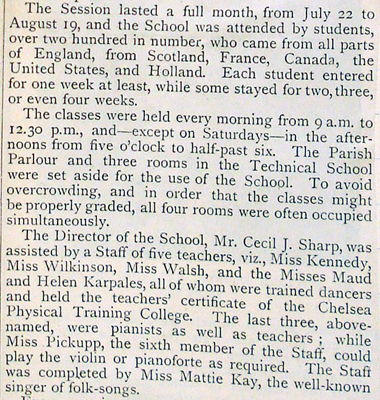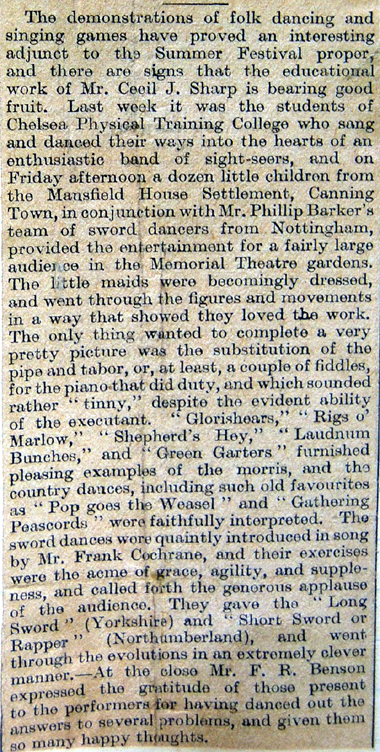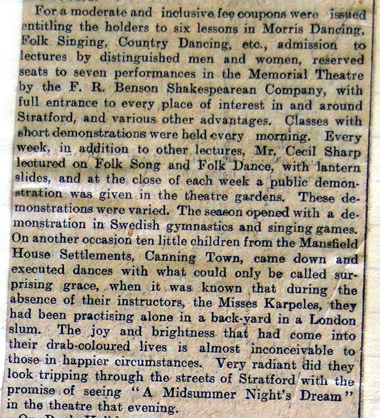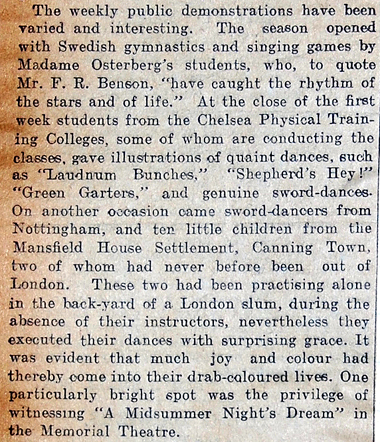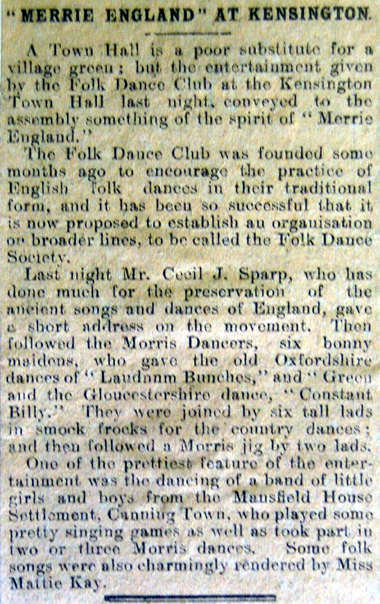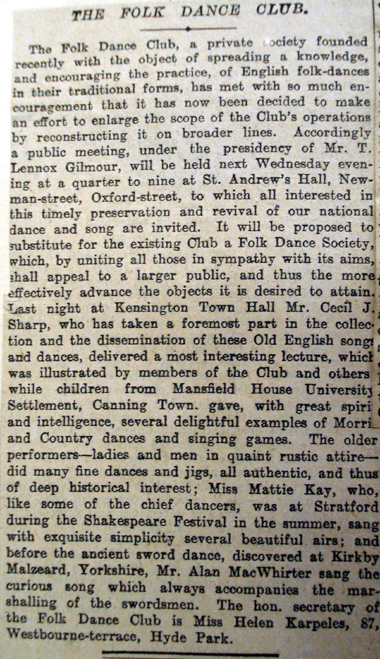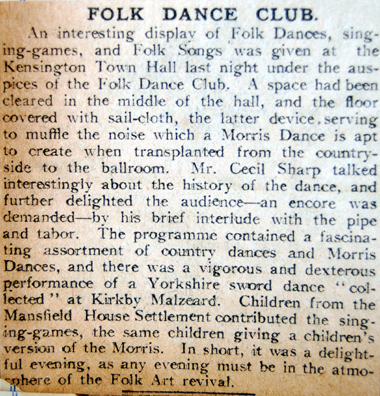| 
Children dancing the
maypole dance in the garden of Mansfield House in the 1890s
- what Maud later described as being a 'made up dance'. |
|
A folk dance and song summer school had been founded
at Stratford-upon-Avon in the mid-1900s, and originally Mary Neal’s
‘Esperance’ girls had demonstrated and taught there. However,
Cecil Sharp’s relationship with Neal was already problematic by
the time that Maud Karpeles first saw them judging together in Stratford-upon-Avon
in 1909. Neal focused on the spirit of the dances, and saw their usefulness
within a wider social context. Sharp, however, believed in the importance
of preserving the purity of the choreography and of recognizing folk
dancing as an art form in its own right: “philanthropy and art
have nothing in common.”
Sharp therefore became increasingly concerned about
the freer interpretation of Morris dances by the Esperance girls, and
the loss of ‘authenticity’ this adaptation created, and
welcomed the rigorous way in which Maud was teaching the Canning Town
children. After Neal challenged Sharp’s claim that the choreography
he had ‘collected’ was in any case ‘pure’, the
Governors of the Shakespeare Memorial Theatre were forced to take sides.
They eventually came down in support of Sharp, and so his teachers and
dancers replaced the Esperance girls at the summer school. This, of
course, included the Karpeles sisters.
(The Esperance girls never recovered their past fame.
At the outbreak of the First World War Mary Neal moved on to other activities,
and her Club closed its doors for good. However, the Esperance Girls
have always retained their rightful place in folk dance history.)

Undated image of Mansfield House boys practising
sword dancing
Cecil Sharp’s 1911 summer school at Stratford
Upon Avon ran for several weeks, with some people attending for the
whole period and others for just a week. Many of the students were teachers,
who wished to learn the dances in order to teach their pupils when term
started again. Sharp had succeeded in making folk dancing part of the
state school curriculum, and teachers could often earn higher salaries
if they had the certificates to prove that they had trained to the required
standard.
Each week of dancing finished with a party and demonstration
by invited dancers. In August 1911, Maud’s Canning Town children
went to Stratford to demonstrate their skills and were an instant success.
Later that year they demonstrated dances and action-songs at Kensington
Town Hall — previously a showcase for the Esperance girls —
where they also received national press coverage.
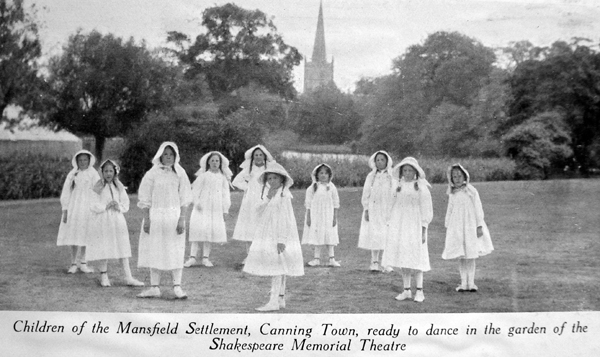
Children of the Mansfield Settlement, Canning Town,
ready to dance in the garden of the Shakespeare Memorial Theatre
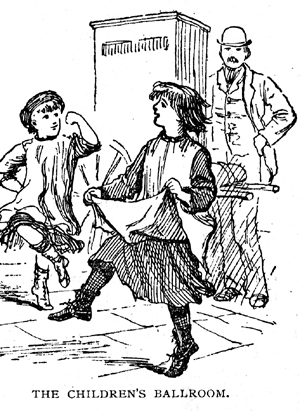 The
Mansfield House Magazine recorded: The
Mansfield House Magazine recorded:
As was mentioned in last month’s Magazine, the
Mansfield House Children’s Folk Song and Dance Club had been
asked to be responsible for one of the weekly demonstrations of folk
dances which were held at Stratford-on-Avon throughout the Summer
Festival.
On the morning of August 3rd, the day before the performance,
the ten girls who had been chosen to take part arrived at Stratford-on-Avon.
After lunch they had a short rehearsal of the dances to be performed
on the following day, and then they attended a lecture on English
Folk Dances by Mr. Cecil Sharp, at which six of the children were
asked to give an illustration of the Morris Dance in the form of “Shepherd’s
Hey.”
At the conclusion of the lecture the children had
tea, and were then taken to the theatre to see a performance of “A
Midsummer Night’s Dream”. For many of the children it
was their first visit to the theatre, and the performance proved quite
a revelation to them. The fairy scenes attracted them most, Puck receiving
the greatest share of admiration. After the performance the children
returned to the inn to bed, and thus ended one happy day.
The next morning they were up betimes, and the hours
between breakfast and lunch were busily spent in sight-seeing, and
in a steamer trip up the river.
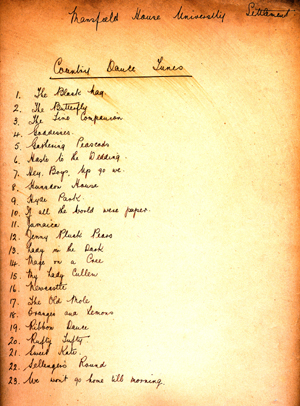 |
Handwritten list of country
dance tunes from the Mansfield House archives. |
In the afternoon the great event, for which the children
had come to Stratford-on-Avon, took place in the Theatre Garden. The
groups of children dancing on the lawn, with the river and the old
Church in the background, formed a very charming picture. The performance
passed off most successfully. The children’s dancing was at
its best, and their efforts were greatly appreciated and warmly applauded
by the audience.
The following is the programme of dances performed
by the children, assisted by a team of sword dancers from Nottingham
: -
1, Morris Dance, Processional (Derbyshire); 2, Morris Dance, “Glorishears”
(Oxon.); 3, Morris Dance, “Rigs o’Marlow (Oxon); 4, Dance
Game, “Three Jolly Sheepskins” (Herefordshire); 5, Country
Dance, “Pop Goes the Weasel” (Worcestershire); 6, Singing
Game, “Push the Business On” (Somerset); 7, Sword Dance,
“Long Sword” (Yorkshire); 8, Country Dance, Ribbon Dance
(Somerset);
9, Country Dance, “The Black Nag” (Playford’s English
Dancing Master, 1650);
10, Morris Dance, “Shepherd’s Hey’ (Oxon.); 11,
Country Dance, “Jenny Pluck Pears” (Playford’s English
Dancing Master, 1650); 12, Country Dance, “Hey boys, up go we”
(Playford’s English Dancing Master, 1650); 13, Singing Game,
“A hunting we will go” (Derbyshire); 14, Sword Dance,
Short Sword, or Rapper (Earsdon);
15, Country Dance, “Grimstock” (Playford’s English
Dancing Master, 1650);
16, Country Dance, “Gathering Peascods” (Playford’s
English Dancing Master, 1650); 17, Morris Dance, “Laudnum Bunches”
(Oxon.); 18, Green Garters (Oxon.).
In spite of this exacting programme the children still
had sufficient energy to dance the Processional Morris, headed by
a fiddler, through the streets of Stratford until they reached the
Shakespeare Hotel, where they had been invited out to tea.
After tea the children wound up with a chorus of folk
songs, and then, alas, it was time to hurry off to the station. Great
was the children’s regret at having to leave Stratford-on-Avon,
but they were cheered by the thought of being able to relate their
happy experiences to their families and friends in Canning Town.
The above images come from the English Folk Dance Society/Aston
Mansfield archives in Newham Archives at Stratford Library, and should
not be reproduced without permission.
Read next page
Return to Home
Page
Return to top of page
Text © Ju
Gosling aka ju90 2010

|

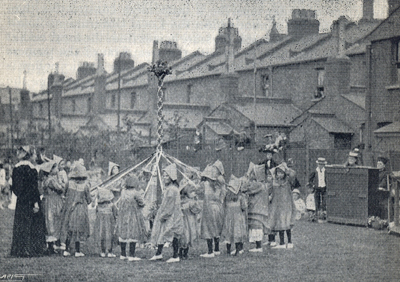


 The
Mansfield House Magazine recorded:
The
Mansfield House Magazine recorded:
